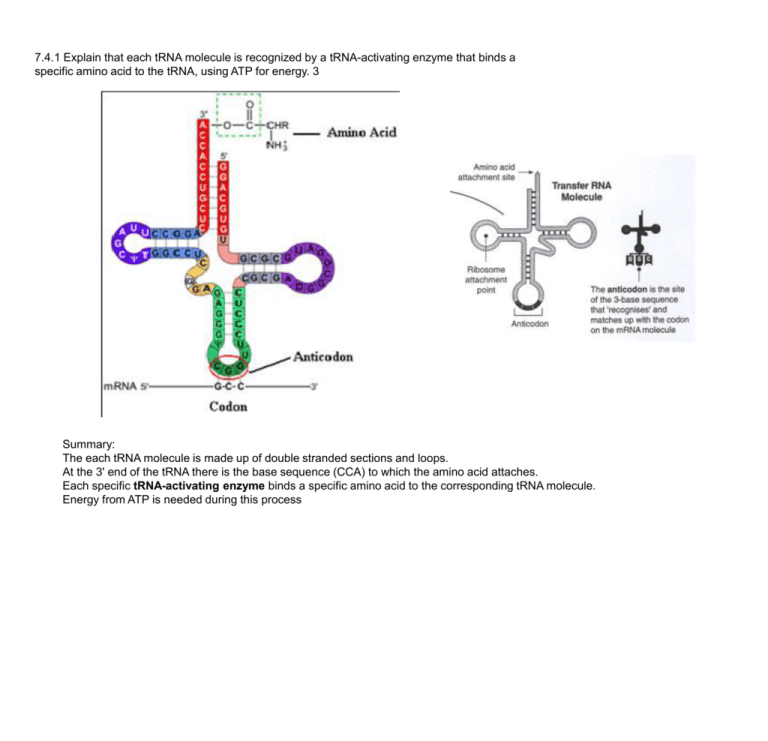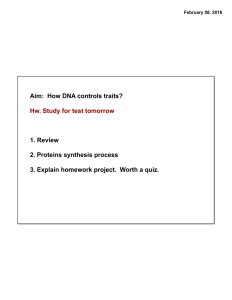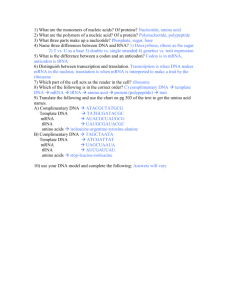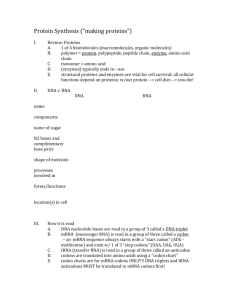
7.4.1 Explain that each tRNA molecule is recognized by a tRNA-activating enzyme that binds a
specific amino acid to the tRNA, using ATP for energy. 3
Summary:
The each tRNA molecule is made up of double stranded sections and loops.
At the 3' end of the tRNA there is the base sequence (CCA) to which the amino acid attaches.
Each specific tRNA-activating enzyme binds a specific amino acid to the corresponding tRNA molecule.
Energy from ATP is needed during this process
7.4.2 Outline the structure of ribosomes, including protein and RNA composition, large and small
subunits, three tRNA binding sites and mRNA binding sites. 2
Ribosomes have a particular structure.
They are made up of proteins and ribosomal RNA.
They have two subunits, one large the other small.
On the surface of the ribosome there are three sites to which tRNA can bind to.
However not more than two tRNA molecules can bind to the ribosome at one time.
Also there is a site on the surface of the ribosome to which mRNA can bind to.
7.4.3 State that translation consists of initiation, elongation, translocation and termination.1
7.4.4 State that translation occurs in a 5' -> 3' direction. 1
7.4.5 Draw and label a diagram showing the structure of a peptide bond between two amino acids. 1
7.4.7 State that free ribosomes synthesize proteins for use primarily within the cell, and that bound ribosomes synthesize
proteins primarily for secretion or for lysosomes. 1
7.4.6 Explain ..... polysomes, start codons and stop codons. 3
Extension work .....
Using the slide below to try to build your own protein using
·DNA
·mRNA
·tRNA
·ribosomes
·amino acids
How DNA Makes Proteins
Directions:
1. Drag the lower half of the gene's DNA down, keeping it in the nucleus.
2. Drag mRNA nucleotides from the nucleolus to match their complementary pairs on the upper half of
the gene's DNA.
3. When all complementary pairs have been matched, drag the words 'messenger RNA (mRNA)' close
to the newly formed mRNA strand.
4. Holding down the 'Ctrl' key tap on 'messenger RNA (mRNA)' and each of the mRNA nucleotides.
When all are selected, click the drop box on one of them and group them.
5. Drag the mRNA strand out of the nucleus.
6. Drag the lower have of the gene's DNA back to its original position.
7. Drag the mRNA strand so its left end is where the two circles of the ribosome meet.
8. Drag the ribosome over the first 3 nucleotides.
9. Find the tRNA and amino acid that matches complementary pairs with the first 3 nucleotides on the
mRNA. Drag one into position.
10. Drag the ribosome to the right over the next 3 nucleotides. Repeat step 9 for these three.
11. Click and ungroup each of the tRNA and amino acids.
12. Drag each amino acid up and away from the tRNA.
13. Connect them with a peptide bond.
14. Drag the ribosome to the right over the next 3 nucleotides. Repeat step 9 for these three.
15. Repeat steps 11-13 to bond this amino acid to the others.
16. Repeat steps 14-15 for the final 3 nucleotides.
Hint: When you're done close without saving so the program will reset.
mes
nucleus
Ribosome;
made of ribosomal
RNA (rRNA)
nucleolus
cytoplasm
Peptide bonds
transfer RNA (tRNA) with amino acids
Subject
NCSCOS
Topic
SLIDES 7 & 8 Exploring Biotechnology EB6828
EB04.03 Explore the structure of DNA and its
relationship to the cell.
DNA Coding for Proteins
Title
DNA to Protein
Grade(s)
7-12
Cross-curricular link(s)
Prior knowledge
Intended learning outcome(s)
Recommended usage
Submitted by
How to use Notebook(TM) software
Learn helpful tips and tricks for developing and presenting lesson activities.
© 2006 SMART Technologies Inc. All rights reserved. For further information, please see copyright notice.
Type any cross-curricular links in here
Knowledge of DNA molecular structure
·The student will learn that DNA codes for proteins
·The student will see the role of DNA, mRNA, rRNA, and tRNA in protein
production
·The student will learn using hands-on techniques
Presentation of protein production
Practice after presenting the process of protein production
Kurt Lawrence







